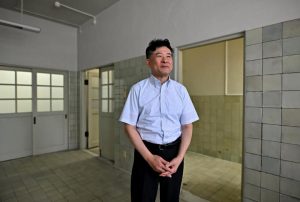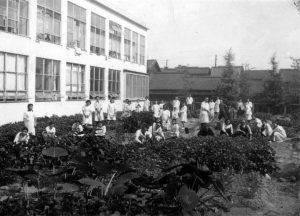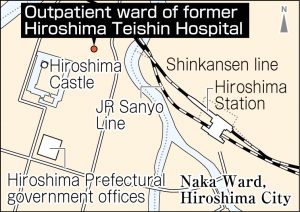Memories engraved in A-bombed buildings, Part 5: Hiroshima Teishin Hospital
Jul. 25, 2024
Presence of grandfather, who put everything into providing aid and relief, is sensed
by Minami Yamashita, Staff Writer
From the day of the atomic bombing, Hiroshima Teishin Hospital (in the city’s present-day Naka Ward), located about 1.4 kilometers from the hypocenter, was flooded with the wounded seeking help. In his memoirs titled Hiroshima Diary, Michihiko Hachiya, director of the hospital at the time who died in 1980 at the age of 76, wrote an account of his experiences during the course of 56 days, detailing the cruelty of the atomic bombing. He also included the name of a pharmacist in the August 6 entry who had devoted himself to helping the wounded and putting out the fires in the hospital immediately after the atomic bombing.
Prevented first floor from being incinerated
“Mr. Hinoi rushed in like a falcon in flight and forcibly pulled me up.” In front of the hospital engulfed in raging fires, the wounded Mr. Hachiya found himself unable to move. He was rescued by Akio Hinoi, who was 38 at the time and worked as head of the hospital pharmacy. He was involved in the initial firefighting efforts, working to prevent the first floor, which housed the examination and other rooms, from being incinerated.
“I heard that he was clever, and a kind and devoted husband,” Mr. Hinoi’s grandson Takao, 60, a resident of Hiroshima’s Minami Ward, said proudly. Graduating from Meiji Pharmaceutical School (present-day Meiji Pharmaceutical University), Mr. Hinoi began working at Hiroshima Teishin Hospital as a pharmacist in 1940. He was living in the area of Gion-cho (now part of the city’s Asaminami Ward) together with the other three members of his family and experienced the atomic bombing in the hospital’s basement.
Mr. Hinoi’s oldest son, Hideo, a physician who died in 2018 at the age of 82, recalled in his journal, “My father did his best to care for many severely wounded people, including the hospital director, Dr. Hachiya, and the doctor’s wife. We thought he had been killed in the atomic bombing, but he struggled to return home in the evening and collapsed from exhaustion with wounds over his entire body. The gratitude (to the gods and Buddha) and the emotion felt by the entire family and other relatives at that time were indescribable.”
After the war, Mr. Hinoi did not speak much to his family about the aid and relief work in which he was engaged at the time. However, his statement remains in Hiroshima Genbaku Iryoshi (in English, ‘History of Hiroshima atomic bomb medical treatment’) in a record of a roundtable discussion held in 1952 by Hiroshima Teishin Hospital staff recalling the time of the atomic bombing. “Because patients flooded into the hospital every day, even though we were receiving medical supplies from Hiroshima Prefecture, they would soon run out. We made great efforts to obtain medicine.” The August 11 entry in Hiroshima Diary details the work of hospital staff as they traveled around the city in search of relief supplies.
In 1950, Mr. Hinoi retired from Hiroshima Teishin Hospital and opened a pharmacy in front of Yokogawa Station (in the city’s present-day Nishi Ward). He worked almost every day throughout the year, repeating that, “I want those suffering from injuries and illnesses to be able to get treatment at any time.” He is said to have received a first edition of Hiroshima Diary from Dr. Hachiya, who came to visit him at the pharmacy. Mr. Hinoi died of leukemia 22 years after the atomic bombing at the age of 59.
Together with “Diary”
After having watched his grandfather and father contribute to community health care, Takao Hinoi also went into medicine. He is currently a professor in the Department of Clinical and Molecular Genetics at Hiroshima University Hospital, located in the city’s Minami Ward, where he works on genomic medicine, a field that utilizes gene information for treatment and diagnosis. Dr. Hinoi said, “I felt my grandfather’s support of Dr. Hachiya immediately after the atomic bombing was the ultimate in team medicine. As a medical professional, I respect him.”
On July 10, Takao paid a visit to the A-bomb archives room in the outpatient ward of the former Hiroshima Teishin Hospital, where part of the original building remains. “With preservation of both the building and Hiroshima Diary, what happened at this hospital can be powerfully communicated to future generations. I hope the exhibits will be updated and more people will visit from both Japan and overseas,” said Takao. Touching the tiles that remain as they were at the time of the bombing, he seemed to sense the presence of his grandfather.
Keywords
Former Hiroshima Teishin Hospital’s Outpatient Ward
Hiroshima Teishin Hospital was completed in 1935 as the Hiroshima Teishin Clinic. Designed by architect Mamoru Yamada, who also designed the Nippon Budokan (in Tokyo), the clinic featured expansive windows and a solarium on the third floor. As a measure against air raids, all inpatients had been discharged from the hospital by July 7, 1945. On the day of the atomic bombing, only hospital staff remained at the hospital and one of them died in the bombing. In 1995, the Chugoku Postal Administration Office opened part of the former outpatient ward as an A-bomb archives room, and in 2018, Japan Post Holdings donated the former outpatient ward to the Hiroshima City government. That ward is scheduled to be renovated and reopened in November 2025 as an exhibit facility affiliated with the Hiroshima Peace Memorial Museum.
(Originally published on July 25, 2024)











